| PROJECTS |
|
| Research Topics |
| Measurement of BTDF and rendering of woven cloth - Production of curtain catalog animation - |
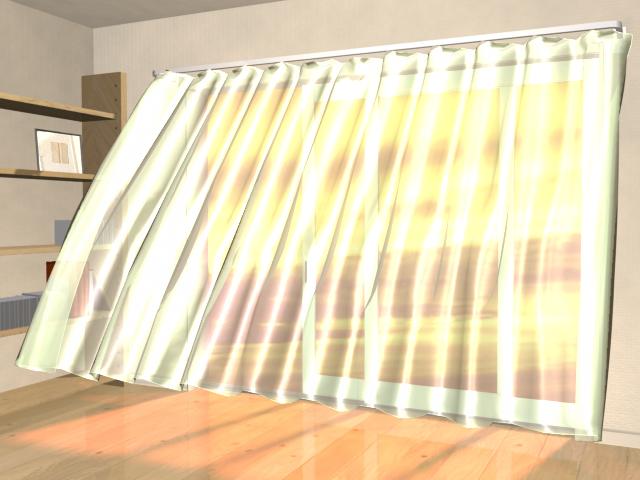 Click the above image to start movie |
The need for rendering woven fabrics arises
frequently in computer graphics. We propose rendering methods for woven fabrics, particularly transparent fabrics such as lace, based on a BTDF (bidirectional transmittance distribution function) model. We measured the BTDF of the two woven fabrics by using a BRDF instrument and made the following observations: (1) a woven fabric has the property of bidirectional transmittance and scattering and (2)transmitted light consists of two components.diffusional and directional transmission. We then proposed a standardized model consistings of two components.diffusional and directional transmission that are defined by the Two-term Henyey-Greenstein function. The measured BTDF data was fit by the BTDF model proposed in this study and the woven fabrics was rendered using the same model. We verified the adequacy of the obtained BTDF model by comparing the results of this model with the results of rendering using the measured BTDFs. Moreover, a real-time rendering algorithm of this BTDF model was programmed based on a BTDF texture look-up table. It was implemented by using a combination of OpenGL and Nvidia's Cg and realized stable at 60 fps. Our goal is to produce a catalog of curtain animations that can express various kinds of woven fabrics under arbitrary light conditions.
Hitoshi Uno, Yoshiki Mizushima, Noriko Nagata,
Yoshiyuki Sakaguchi (2008). Lace curtain: Measurement of BTDF and rendering of woven cloth - Production of curtain
catalog -, ACM SIGGRAPH 2008: Talks, Full Conference DVD-ROM,
0960-abstract.pdf. |
||
| Computer animation for piano fingering using motion capture and its application to a music interface |
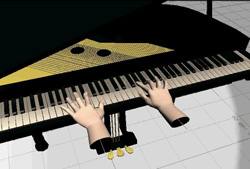 Click the above image to start movie (requires Windows Media Player) |
|||
| Virtual-Kobe Sanda Campus |
 Click the above image to start movie (requires Windows Media Player) |
TBD. | ||
| Color change of objects in virtual environments: Using IBR under a light source with arbitrary spectral distribution |
 |
Image-based rendaring (IBR), an important technique in the field of computer graphics (CG), allows the use of photographs to create textures. IBR has the advantages that a detailed and complicated patterns can be rendered at only a small computational expense, and that it is possible to represent objects more realistically. However, to render the same scene under different light sources corresponding to changes in the season or time of day, a large number of pictures must be acquired according to the different lighting conditions. We propose a technique for determining the color change of an object in virtual environments using illumination-color free IBR (icf-IBR) that can reflect the color of the light source in the color of the object even if the spectral reflectance of the object is unknown. The salient feature of this technique is that it allows us to change the color of an object in a picture taken under a certain light source even if the spectral reflectance of the object is unknown by using the spectral sensitivity of the camera and the spectral distribution of the original light source. We measured the spectral sensitivity characteristics of a digital camera and confirmed that the color of sun light on an arbitrary date could be simulated and that the color of the texture image could be changed appropriately. | ||
| Click for larger image | |||
| Quality of Multimedia Contents - Interactions between Pictures and Music in TV Commercials |
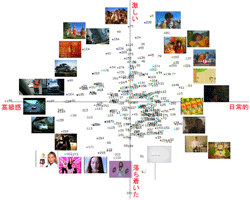 Click for larger image |
During the production of musical pieces and motion pictures, music befitting the pictures and pictures matching the music are often added to enhance the impression they provide. If it is possible to determine the elements of the parameters in music and pictures that produce such effects, they could be applied to the support systems for producing multimedia contents. Thus far, we have been engaged mainly in the study of the relationship between color and music with attention toward “color hearing,” a type of synaesthesia. In this study, we analyze the interaction between the pictures and music in TV commercials. In particular, we focus on the color and music tonality. Multiplex correspondence analysis was applied to 282 commercials on the basis of 96 categories of musical expressions and picture expressions. As a result, each element of a picture and music is related to the image, which is also true for TV commercials. In particular, we determined the relationship between tonality and theme color. By using this result, we plan to design a system that can evaluate how well pictures and music are matched. | ||
| Construction of a jazz improvisation automatic generation system |
 |
TBD. | ||
| Estimation of One's Subjective Age Using Facial Images |
 |
This study proposes a method of estimating one's subjective age, which is defined person's own age imagined by himself, using other people's facial images and their real age. Observers were shown facial images to evaluate, using 5 rating scales, whether the facial images looked older or younger than themselves. The results are plotted on a 2-dimensional Plane, on which the x-axis is the difference in the real age between the observers and the facial images, and the y-axis is rating value. The evaluation results of 156 observers between 25 and 54 years old show that firstly the shift value of subjective age tends to be in the negative direction, that is to say, person usually judges their subjective age is to be younger than their real age. Second, the subjective age of young people tends to be estimated lower than their actual age. On the other hand, as the observers get older, the shift value comes close to their actual age. Third, the shift value of male observers is lower than the shift value of female observers. These studies suggest that a new social psychological scale has been found, which differ from the traditional view of subjective age that one see oneself as being younger than one really is as one gets older. | ||
| Measurement of mental state while watching media contents based on physiological indicators |
 |
TBD. | ||
| An fMRI Study of Synesthesia - Brain activity in colored-hearing |
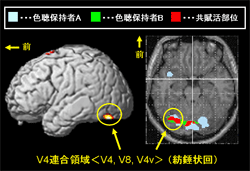 Click for larger image |
In this study, we measured brain activity in colored-hearing (musical tonality - color) synesthesia, in which a person sees colors when listening to music, by using functional magnetic resonance imaging (fMRI). We compared the images acquired from two colored-hearing subjects and 11 non-colored-hearing subjects when listening to various kinds of music. The results showed that the fusiform gyrus, cerebellum, right lateral inferior parietal lobule and superior frontal gyrus were activated only in the colored-hearing synesthetes. Moreover we found that the area of activity in the cerebellum and the color area, V4/V8 (V4 complex), in the fusiform gyrus which was also activated, are next to each other, and were activated simultaneously. This result indicates that colored-hearing synesthetes actually perceive colors when listening to music and that they experience a direct interaction between the auditory and visual modalities. In addition, this provides evidence for the synesthesia cross-wiring hypothesis that there is a strong neurological connection between the color V4 complex and the cerebellum, and that the activity in the V4 complex occurs as a result of the activity in the cerebellum caused by listening to music. Brain Activity in Colored-hearing Synesthetes when Listening to Tonal Music. |
||
| Feature Analysis of curves in Buddhist Statue Faces |
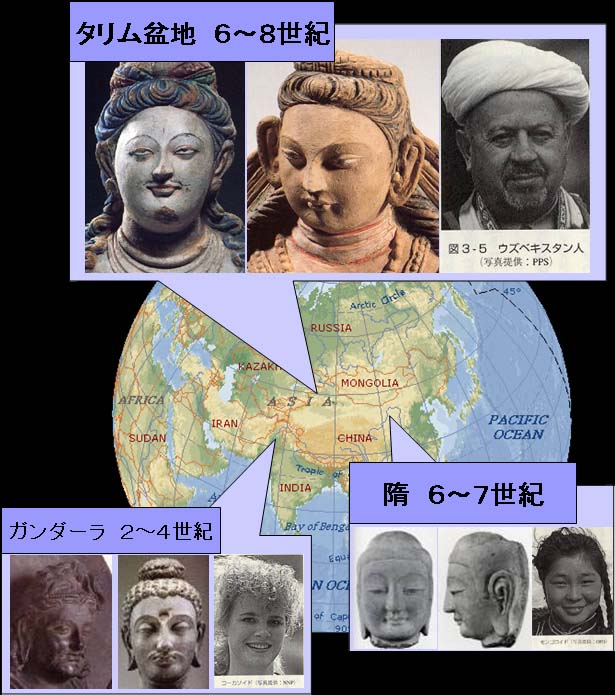 |
Feature Analysis of curves in Buddhist Statue Faces. | ||
Click for larger image |
|||
| Modeling and Visualization for a Pearl Quality Evaluation Simulator |
 Click for larger image |
Visual simulation using CG and VR has attracted wide attention in the machine vision field. This study proposes a method of modeling and visualizing pearls that will be the central technique of a pearl quality evaluation simulator. Pearls manifest a very specific optical phenomenon that is not dependent on the direction of the light source. To investigate this feature, we propose a physical model called an “illuminant model” for multilayer film interference considering the multiple reflection in spherical bodies. The rendering algorithm has been configured from such representations of physical characteristics as interference, mirroring and texture which correspond respectively to the sense of depth, brightness and grain that are the main evaluation factors obtained from psychological experiments. Further, portions of photos of real pearls and the images generated by the present method were evaluated based on a scale of psychological evaluation of “pearl-like quality” demonstrating thereby that not merely the generated images as a whole but the respective parts of images can present such a pearl-like quality. | ||